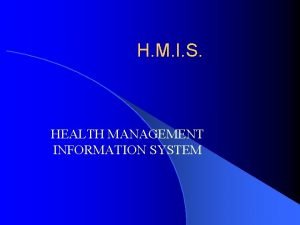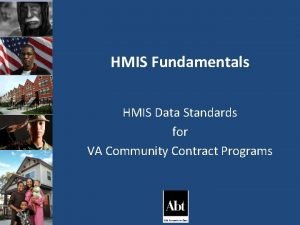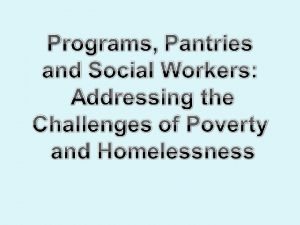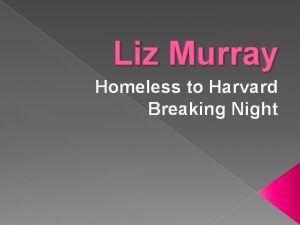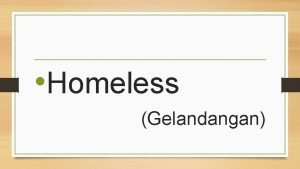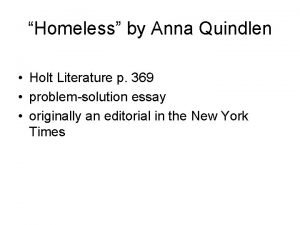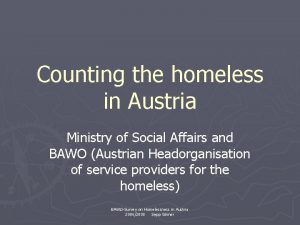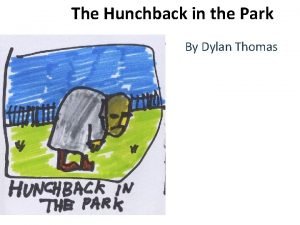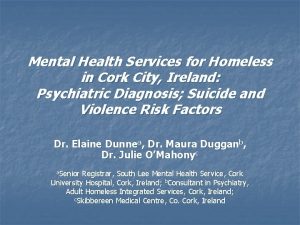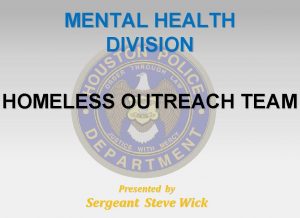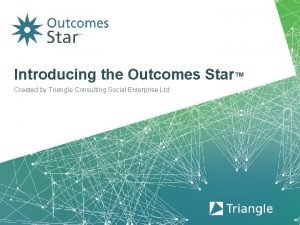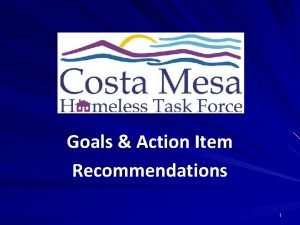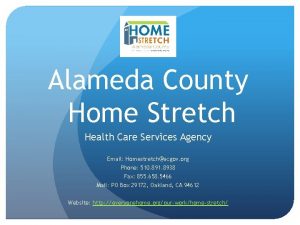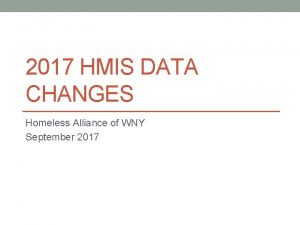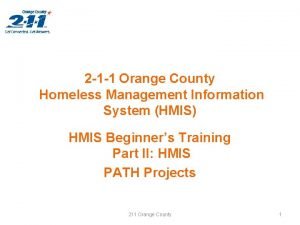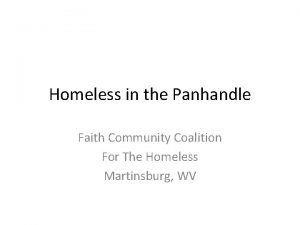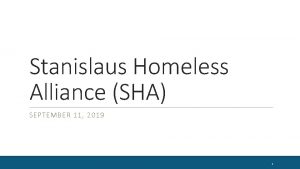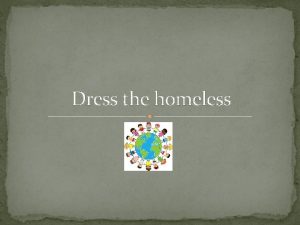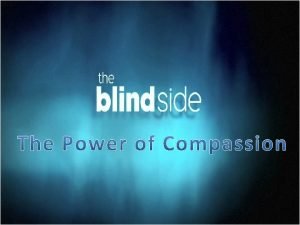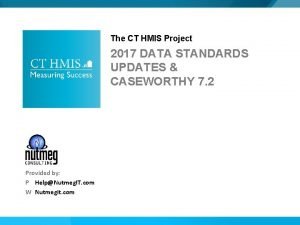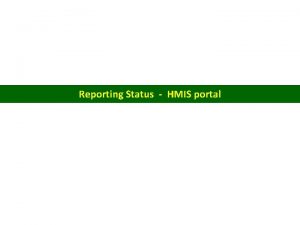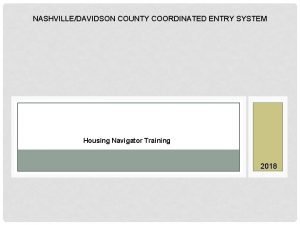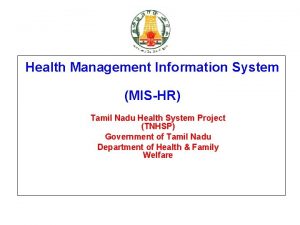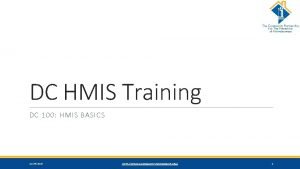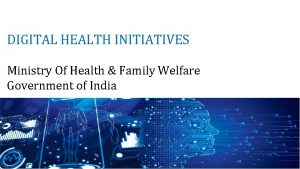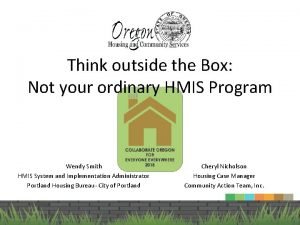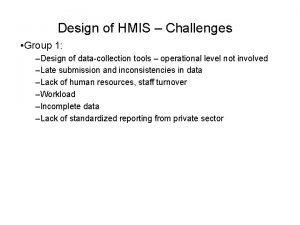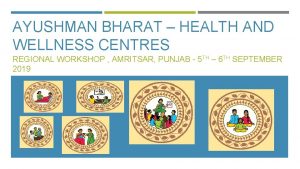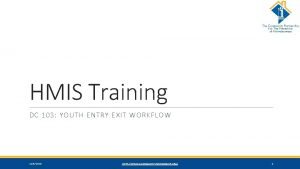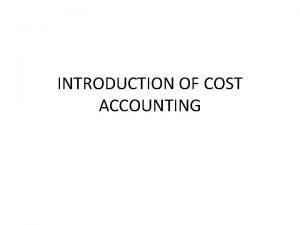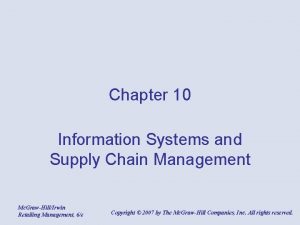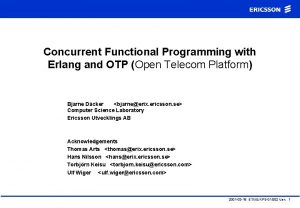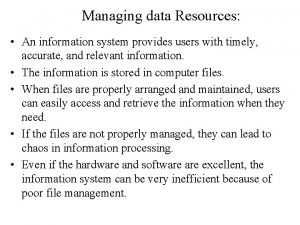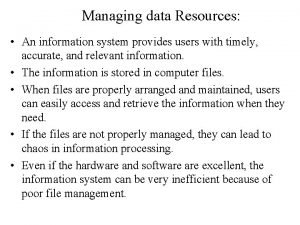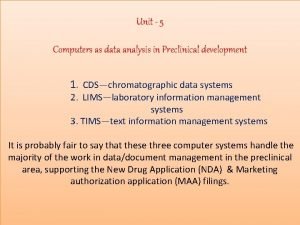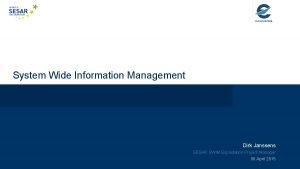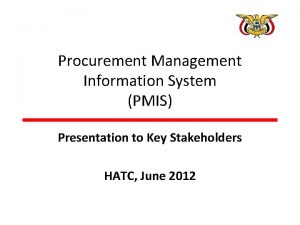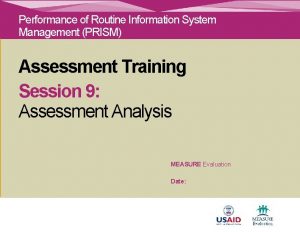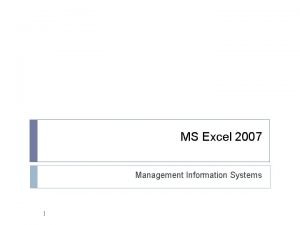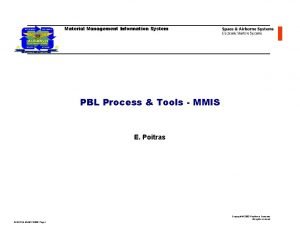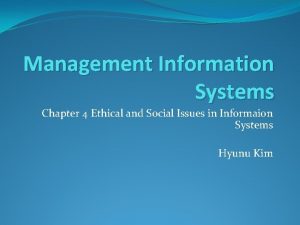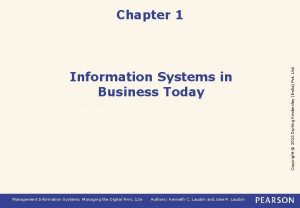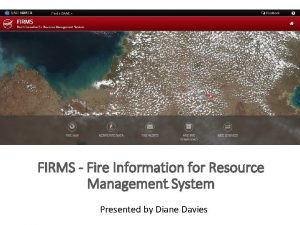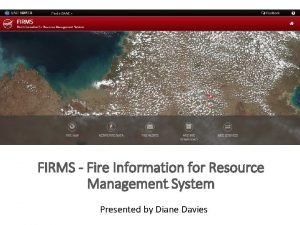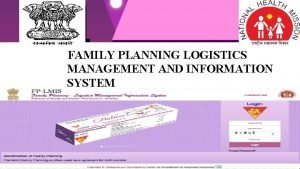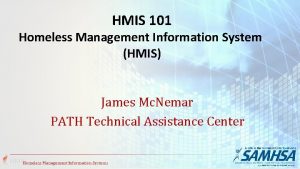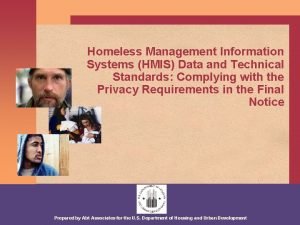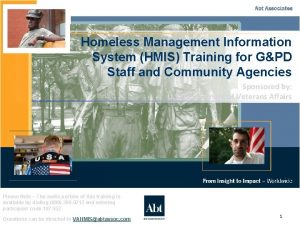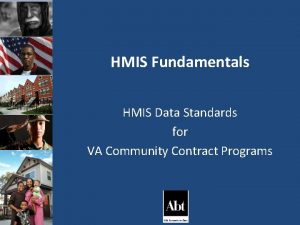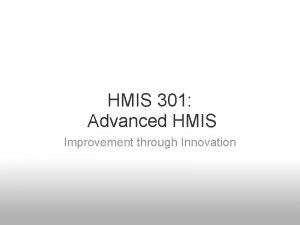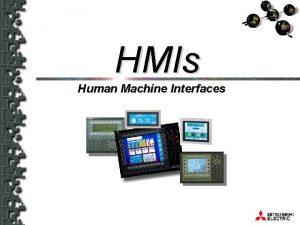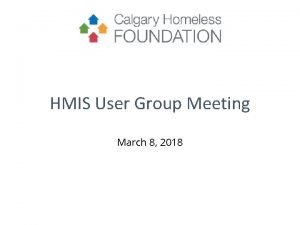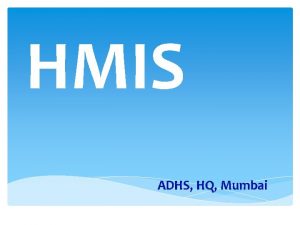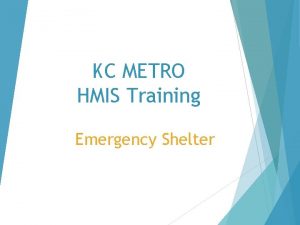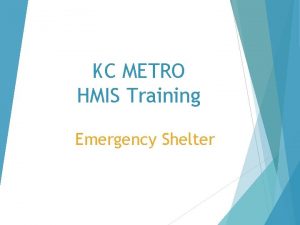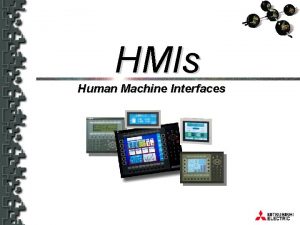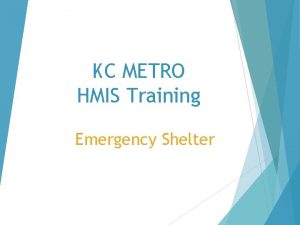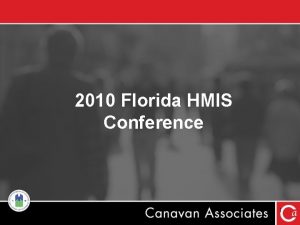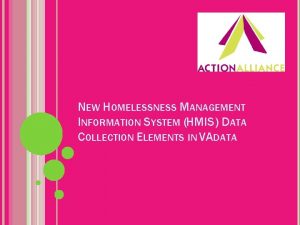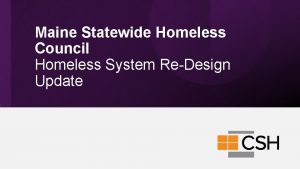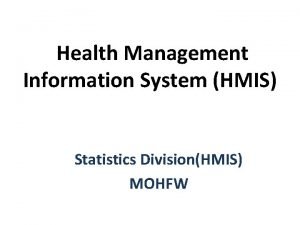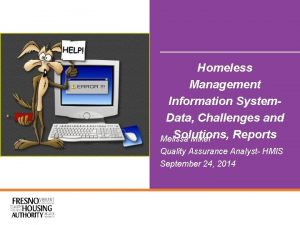Homeless Management Information System HMIS Data and Technical



































































- Slides: 67

Homeless Management Information System (HMIS) Data and Technical Standards: Participation and Data Collection Requirements Prepared by Abt Associates for the U. S. Department of Housing and Urban Development

HMIS Data and Technical Standards Training • This is training module 2 of a 4 part series addressing the following components of the Final HMIS Data and Technical Standards. – Training 1: Overview – Training 2: Participation and Data Collection Requirements – Training 3: Privacy Standards – Training 4: Security and Technical Standards Prepared by Abt Associates for the U. S. Department of Housing and Urban Development 2

Companion Training Materials • This training module features an accompanying set of handouts that include: – HMIS Prioritization Chart – HMIS Data and Technical Standards Frequently Asked Questions • Training materials can be found at www. hmis. info Prepared by Abt Associates for the U. S. Department of Housing and Urban Development 3

Overview • Participation Requirements • Universal Data Elements • Program Level Data Elements • Continua of Care (Co. C) Requirements • Summary Prepared by Abt Associates for the U. S. Department of Housing and Urban Development 4

Participation Requirements • All programs participating in HMIS must collect universal data elements • Programs that receive funding through Mc. Kinney-Vento that produce an Annual Progress Report (APR) must also collect program level data elements – This includes: Supportive Housing Program (SHP), Shelter Plus Care (S+C), Section 8 Mod Rehab, Emergency Shelter Grants (ESG), and Housing Opportunities for People With AIDS (HOPWA) funded programs • HUD encourages participation of all homeless service providers including other federally funded programs Prepared by Abt Associates for the U. S. Department of Housing and Urban Development 5

Participation Requirements - Domestic Violence Providers • In January 2006, the Violence Against Women Act (VAWA) Reauthorization of 2005 became law. • VAWA contains provisions that amend the Mc. Kinney. Vento Homeless Assistance Act relating to the disclosure of data to HMIS by domestic violence providers. This legislation can be found at http: //thomas. loc. gov/cgibin/bdquery/z? d 109: h 3402: • HUD is analyzing the legislation to determine the most appropriate instructions and advice to convey to communities and domestic violence programs Prepared by Abt Associates for the U. S. Department of Housing and Urban Development 6

Participation Requirements- Prioritization • Prioritization for inclusion in HMIS should be given to programs in the following order: – 1. Emergency shelters, transitional housing, and outreach programs; – 2. Permanent supportive housing funded by HUD Mc. Kinney -Vento Act programs and other HUD programs; – 3. Homeless prevention programs, supportive services only (SHP), and non-federally funded permanent housing programs. • Handout: HMIS Prioritization Chart (Page 45094 of the HMIS Data and Technical Standards) Prepared by Abt Associates for the U. S. Department of Housing and Urban Development 7

Data Collection • Data Collection Requirements: – Universal Data Elements • All programs participating in HMIS must collect on all clients served • Records demographics, characteristics and patterns of service use of homeless persons – Program-Specific Data Elements • Required to collect by all Mc. Kinney-Vento programs that must complete an Annual Progress Report (APR) • Records needs assessments, service use, and outcomes • Handout: HMIS Data and Technical Standards Frequently Asked Questions Prepared by Abt Associates for the U. S. Department of Housing and Urban Development 8

Overview of Universal Data Elements 1. Name 2. Social Security Number 3. Date of Birth 4. Ethnicity and Race 5. Gender 6. Veterans Status 7. Disabling Condition 8. Residence Prior to Program 9. Zip Code of Last Permanent Address 10. Program Entry Date 11. Program Exit Date 12. Person ID Number* 13. Program ID Number* 14. Household ID Number* * Computer Generated Entry Prepared by Abt Associates for the U. S. Department of Housing and Urban Development 9

Universal Data Elements: Unduplication Goal: To produce an accurate count of homeless persons and to increase the use of mainstream programs by homeless persons. Date of birth can also be used to calculate a person’s age. 1. Name 2. Social Security Number 3. Date of Birth Prepared by Abt Associates for the U. S. Department of Housing and Urban Development 10

Universal Data Element: Name – When Data Are Collected: Upon initial program entry/intake. – Subjects: All clients served. – Definition and Instructions: • In four separate fields record the legal full, middle, last names and any suffixes (avoid aliases or nicknames) • Record any other name used to receive services previously • Response Format: John David Doe Jr. Prepared by Abt Associates for the U. S. Department of Housing and Urban Development 11

Universal Data Element: Social Security Number (SSN) – When Data Are Collected: Upon initial program entry/intake. – Subjects: All clients served. – Definition and Instructions: In two separate fields record: • Nine-digit Social Security Number • Quality of the data (Full SSN, Partial SSN, Don’t Know or Don’t Have, Refused) • Response Format: 123456789 Prepared by Abt Associates for the U. S. Department of Housing and Urban Development 12

Universal Data Elements: Date of Birth (DOB) • Date of Birth (DOB) – When Data Are Collected: Upon initial program entry/intake. – Subjects: All clients served. – Definition and Instructions: Collect the month, day and year of birth for every person served. • If a client cannot remember the year of birth, ask their age and calculate the approximate year of birth. • Response Format: 08/31/1965, or if the DOB is unknown but age is known: AGE 30 = 01/01/1976 Prepared by Abt Associates for the U. S. Department of Housing and Urban Development 13

Universal Data Elements: Demographics Goal: To understand who is homeless and to identify persons who may qualify for other types of programs. 4. Ethnicity and Race 5. Gender 6. Veteran Status 7. Disabling Condition Prepared by Abt Associates for the U. S. Department of Housing and Urban Development 14

Universal Data Elements: Ethnicity and Race – When Data Are Collected: Upon initial program entry. – Subjects: All clients served. – Definition and Instructions: In two separate fields record both the self-identified Hispanic or Latino ethnicity and the self-identified race of each client served. • Allow clients to identify multiple racial categories. • Staff observation should NOT be used to collect this information. Prepared by Abt Associates for the U. S. Department of Housing and Urban Development 15

Universal Data Elements: Ethnicity and Race (con’t) Ethnicity and Race Response Categories: Ethnicity Non-Hispanic/Latino Race American Indian or Alaskan Native Asian Black or African-American Native Hawaiian or Other Pacific Islander White Prepared by Abt Associates for the U. S. Department of Housing and Urban Development 16

Universal Data Elements: Gender – When Data Are Collected: Upon initial program entry. – Subjects: All clients served. – Definition and Instructions: Record the gender of each client served. • Programs may add “transgender male to female” and “transgender female to male” categories. • Response Categories: Female, Male Prepared by Abt Associates for the U. S. Department of Housing and Urban Development 17

Universal Data Elements: Veteran Status – When Data Are Collected: Upon each program entry. – Subjects: All adults served. – Definition and Instructions: A veteran is someone who has served on active duty in the Armed Forces of the United States. • This does not include inactive military reserves or the National Guard unless the person was called up to active duty. • Response Categories: No, Yes Prepared by Abt Associates for the U. S. Department of Housing and Urban Development 18

Universal Data Elements: Disabling Condition – When Data Are Collected: After the client has been admitted into the program. – Subjects: All adults served. – Definition and Instructions: A disabling condition means: • A disability as defined in Section 223 of the Social Security Act. • A physical, mental or emotional impairment which is of longcontinued and indefinite duration, substantially impedes ones ability to function independently, and of such a nature that such ability could be improved by more suitable housing conditions. Prepared by Abt Associates for the U. S. Department of Housing and Urban Development 19

Universal Data Elements: Disabling Condition (con’t) Disabling Condition • Definition and Instructions (con’t): 1. A developmental disability as defined in Section 102 of the Developmental Disabilities Assistance and Bill of Rights Act. 2. The disease of AIDS or any conditions arising from the etiological agency of AIDS. 3. A diagnosable substance abuse disorder. • Response Categories: No, Yes, Don’t Know, Refused Prepared by Abt Associates for the U. S. Department of Housing and Urban Development 20

Universal Data Elements: Housing and Service Use Goal: To understand the mobility of homeless persons and service use patterns. 8. Residence Prior to Program Entry 9. Zip Code of Last Permanent Address 10. Program Entry Date 11. Program Exit Date Prepared by Abt Associates for the U. S. Department of Housing and Urban Development 21

Universal Data Element: Residence Prior to Program Entry – When Data Are Collected: Any time after the client has been admitted into the program. – Subjects: All adults and unaccompanied youth served. – Definition and Instructions: In two separate fields record the type of living arrangement the night before entry into the program and the length of time the client spent in that living arrangement. Prepared by Abt Associates for the U. S. Department of Housing and Urban Development 22

Universal Data Element: Residence Prior to Program Entry (con’t) Type of Residence Emergency Shelter (including a youth shelter, or hotel, motel, or campground paid for with emergency shelter voucher) Transitional Housing for Homeless persons (including homeless youth) Permanent housing formerly homeless persons (such as SHP, S+C, or SRO Mod Rehab) Psychiatric hospital or other psychiatric facility Substance abuse treatment facility or detox center Hospital (non-psychiatric) Jail, prison or juvenile detention facility Room, apartment, or house that you rent Apartment or house that you own Staying or living in a family member’s room, apartment, or house Staying or living in a friend’s room, apartment, or house Hotel or motel paid for without emergency shelter voucher Foster care home or foster care group home Place not meant for habitation (e. g. , a vehicle, an abandoned building, bus/train/subway station/airport or anywhere outside) Other Don’t know Refused Prepared by Abt Associates for the U. S. Department of Housing and Urban Development 23

Universal Data Element: Residence Prior to Program Entry (con’t) Length of Stay in Previous Place One week or less More than one week, but less than one month One to three months More than three months, but less than one year One year or longer Prepared by Abt Associates for the U. S. Department of Housing and Urban Development 24

Universal Data Element: Zip Code of Last Permanent Address – When Data Are Collected: Upon each program entry. – Subjects: All adults and unaccompanied youth served. – Definition and Instructions: In two separate fields record the five-digit zip code of the apartment, room, or house where the client last lived for 90 days or more, and the zip data quality code. Prepared by Abt Associates for the U. S. Department of Housing and Urban Development 25

Universal Data Element: Zip Code of Last Permanent Address (con’t) Response Format/Categories: Zip Code _ _ _ (example: 12345) Zip Data Quality Code Full Zip recorded Don’t know Refused Prepared by Abt Associates for the U. S. Department of Housing and Urban Development 26

Universal Data Element: Program Entry Date – When Data Are Collected: Upon each program entry. – Subjects: All clients served. – Definition and Instructions: Record the month, day, and year of first day of service of program entry. • For a shelter visit, this date would represent the first day of residence in a shelter program following residence outside of the shelter or in another program. • For services, this date may represent the day of program enrollment, the day a service was provided, or the first date of a period of continuous participation in a service (e. g. , daily, weekly or monthly). • Response Format: 01/30/2004 Prepared by Abt Associates for the U. S. Department of Housing and Urban Development 27

Universal Data Element: Program Exit Date – When Data Are Collected: Upon program exit. – Subjects: All clients served. – Definition and Instructions: Record the month, day, and year of last day of service. • For a program providing housing or shelter, this date would represent the last day of residence in the program’s housing before the client transfers to another residential program or leaves the shelter. • For services, the exit date may represent the last day a service was provided or the last date of a period of continuous service. • Response Format: 01/30/2004 Prepared by Abt Associates for the U. S. Department of Housing and Urban Development 28

Universal Data Element: Program Exit Date (con’t) Missing Exit Dates! – Documented as the most missing variable across the nation —especially for overnight shelters. – Be creative—program your system to automatically exit a client from a bed for short term shelter or use a nightly bed register. – Heighten staff awareness to missing exit dates—training, and more training. Prepared by Abt Associates for the U. S. Department of Housing and Urban Development 29

Overview of Program-Specific Data Elements APR-Required: 1. Income and Sources 7. Substance Abuse 2. Non-Cash Benefits 8. Domestic Violence 3. Physical Disability 9. Services Received 4. Developmental Disability 10. Destination 5. HIV/AIDS 11. Reasons for Leaving 6. Mental Health Prepared by Abt Associates for the U. S. Department of Housing and Urban Development 30

Overview of Program-Specific Data Elements based on recommendations from practitioners, researchers, and other Federal agencies that fund homeless services 12. Employment 13. Education 14. General Health Status 15. Pregnancy Status 16. Veteran’s Information 17. Children’s Education Prepared by Abt Associates for the U. S. Department of Housing and Urban Development 31

Program-Specific Data Elements: Income and Benefits Goal: To understand a client’s level of self-sufficiency and use of mainstream resources 1. Income and Sources 2. Non-Cash Benefits Prepared by Abt Associates for the U. S. Department of Housing and Urban Development 32

Program-Specific Data Element: Income and Sources – When Data Are Collected: In the course of client assessment and at exit. – Subjects: All clients served. – Definition and Instructions: In three separate fields, record: • (1) whether the client received income from each source listed on the next slide in the past 30 days; • (2) the amount of income received from each source identified by the client; and • (3) the client’s total monthly income (rounded to the nearest U. S. dollar). – Allow clients to identify multiple sources of income. Prepared by Abt Associates for the U. S. Department of Housing and Urban Development 33

Program-Specific Data Element: Income and Sources (con’t) Sources of Income Earned Income Unemployment Insurance Supplemental Security Income or SSI Social Security Disability Income or SSDI A veteran’s disability payment Private disability insurance Worker’s compensation Temporary Assistance for Needy Families (TANF) General Assistance Retirement Income from Social Security Veteran’s pension Pension from a former job Child support Alimony or other spousal support Other source No financial resources $____. 00 $____. 00 N/A Total Monthly Income $ _ _. 00 Prepared by Abt Associates for the U. S. Department of Housing and Urban Development 34

Program-Specific Data Element: Non-Cash Benefits – When Data Are Collected: In the course of client assessment and at exit. – Subjects: All adults and unaccompanied youth served. – Definition and Instructions: For each source, determine if the client received any of the non-cash benefits in the past month (30 days). • Allow clients to identify multiple sources. Prepared by Abt Associates for the U. S. Department of Housing and Urban Development 35

Program-Specific Data Element: Non-Cash Benefits (con’t) Sources of Non-Cash Benefit Food stamps or money for food on a benefits card MEDICAID health insurance program MEDICARE health insurance program State Children’s Health Insurance Program Special Supplemental Nutrition Program for Women, Infants, and Children Veteran’s Administration (VA) Medical Services TANF Child Care services TANF transportation services Other TANF-funded services Section 8, public housing, or other rental assistance Other source Prepared by Abt Associates for the U. S. Department of Housing and Urban Development 36

Program-Specific Data Elements Goal: To understand who is homeless, determine eligibility for certain types of benefits, and assess the need for services. 3. Physical Disability 4. Developmental Disability 5. HIV/AIDS 6. Mental Health 7. Substance Abuse 8. Domestic Violence 9. Services Received Prepared by Abt Associates for the U. S. Department of Housing and Urban Development 37

Program-Specific Data Element: Physical Disability – When Data Are Collected: In the course of client assessment once the client is admitted, unless this information is needed prior to admission to determine program eligibility. – Subjects: All clients served. – Definition and Instructions: A physical disability includes an impairment which is: • Expected to be of long-continued and indefinite duration; • Substantially impedes an individual’s ability to live independently; and • Of such a nature that such ability could be improved by more suitable housing conditions. • Response Categories: No, Yes Prepared by Abt Associates for the U. S. Department of Housing and Urban Development 38

Program-Specific Data Element: Developmental Disability – When Data Are Collected: In the course of client assessment once the client is admitted, unless this information is needed prior to admission to determine program eligibility. – Subjects: All clients served. – Definition and Instructions: A developmental disability includes: • Severe, chronic disability that is attributed to a mental and/or physical impairment; • Occurs before 22 years of age; and • Limits the capacity for independent living & economic selfsufficiency. • Response Categories: No, Yes Prepared by Abt Associates for the U. S. Department of Housing and Urban Development 39

Program-Specific Data Element: HIV/AIDS – When Data Are Collected: In the course of client assessment once the client is admitted, unless this information is needed prior to admission to determine program eligibility. – Subjects: All adults and unaccompanied youth served. – Definition and Instructions: Determine if the client has been diagnosed with AIDS or has tested positive for HIV. • If the client does not provide the information and it is not in case manager records, leave the response field blank. • Response Categories: No, Yes Prepared by Abt Associates for the U. S. Department of Housing and Urban Development 40

Program-Specific Data Element: Mental Health – When Data Are Collected: In the course of client assessment once the client is admitted, unless this information is needed prior to admission to determine program eligibility. – Subjects: All adults and unaccompanied youth served. – Definition and Instructions: In separate fields, record: • If the client has a mental health problem; • Whether the problem is expected to be of long-continued and indefinite duration, and substantially impedes a client’s ability to live independently; and • A mental health problem may include serious depression, serious anxiety, hallucinations, violent behavior, or thoughts of suicide. Prepared by Abt Associates for the U. S. Department of Housing and Urban Development 41

Program-Specific Data Element: Mental Health (con’t) Response Categories: Mental Health Problem No Yes Expected to be Indefinite and Impairs ability to Live Independently No Yes Prepared by Abt Associates for the U. S. Department of Housing and Urban Development 42

Program-Specific Data Element: Substance Abuse – When Data Are Collected: In the course of client assessment once the client is admitted, unless this information is needed prior to admission to determine program eligibility. – Subjects: All adults and unaccompanied youth served. – Definition and Instructions: In separate fields, record: • If the client has an alcohol or drug abuse problem, or both. • Whether the problem is expected to be of long-continued and indefinite duration, and substantially impedes a client’s ability to live independently. Prepared by Abt Associates for the U. S. Department of Housing and Urban Development 43

Program-Specific Data Element: Substance Abuse (con’t) Response Categories: Substance Abuse Problem Alcohol Abuse Drug Abuse Dually Diagnosed (both alcohol and drug abuse) Expected to be Indefinite and Impairs Ability to Live Independently No Yes Prepared by Abt Associates for the U. S. Department of Housing and Urban Development 44

Program-Specific Data Element: Domestic Violence – When Data Are Collected: In the course of client assessment. – Subjects: All adults and unaccompanied youth served. – Definition and Instructions: In separate fields, record: • If the client has ever been a victim of domestic violence, and if so, • How long ago did the client have the most recent experience. Prepared by Abt Associates for the U. S. Department of Housing and Urban Development 45

Program-Specific Data Element: Domestic Violence (con’t) Response Categories: Domestic Violence Experience No Yes (If yes) When Experience Occurred Within the past three months Three to six months ago From six to twelve months ago More than a year ago Don’t Know Refused Prepared by Abt Associates for the U. S. Department of Housing and Urban Development 46

Program-Specific Data Element: Services Received – When Data Are Collected: In the course of client assessment and at appropriate points during the program stay. – Subjects: All clients served. – Definition and Instructions: For each service encounter, two types of information must be recorded in two separate fields: • The date of service as the two-digit month, two-digit day, and four-digit year; and • The type of service (listed on next slide). Prepared by Abt Associates for the U. S. Department of Housing and Urban Development 47

Program-Specific Data Element: Services Received (con’t) Type of Service Example Food Housing placement Material goods Temporary housing aid & other financial aid Transportation Consumer assistance and protection Criminal justice/legal service Education Health care HIV/AIDS-related services Mental health care/counseling Substance abuse services Employment Case/care management Day care Personal enrichment Outreach Other Emergency food programs & pantries Housing search Clothing and personal hygiene items Rent payment or deposit assistance Bus pass and mass transit tokens Money management counseling and ID help Legal counseling and immigration services GED instruction and bilingual education Disability screening & health care referrals HIV testing, AIDS treatment and counseling Telephone hotlines and psychiatric care Detoxification and alcohol/drug counseling Job development and job search assistance Develop plans for evaluating/serving clients Child care centers and infant care centers Life skills education & social skills training Street outreach Prepared by Abt Associates for the U. S. Department of Housing and Urban Development 48

Program-Specific Data Elements Goal: To understand where homeless people go following service and to identify the barriers and issues clients face in completing a program or staying in a residential facility. 10. Destination 11. Reasons for Leaving Prepared by Abt Associates for the U. S. Department of Housing and Urban Development 49

Program-Specific Data Element: Destination – When Data Are Collected: At program exit. – Subjects: All clients served. – Definition and Instructions: Record in three separate fields: 1. Where the client will be staying after they leave the program; 2. If this move is permanent or transitional (i. e. , temporary); and 3. Does the move involve a HUD subsidy or other subsidy. Prepared by Abt Associates for the U. S. Department of Housing and Urban Development 50

Program-Specific Data Element: Destination (con’t) Destination Emergency Shelter (including a youth shelter, or hotel, motel, or campground paid for with emergency shelter voucher) Transitional Housing for Homeless persons (including homeless youth) Permanent housing formerly homeless persons (such as SHP, S+C, or SRO Mod Rehab) Psychiatric hospital or other psychiatric facility Substance abuse treatment facility or detox center Hospital (non-psychiatric) Jail, prison or juvenile detention facility Room, apartment, or house that you rent Apartment or house that you own Staying or living in a family member’s room, apartment, or house Staying or living in a friend’s room, apartment, or house Hotel or motel paid for without emergency shelter voucher Foster care home or foster care group home Place not meant for habitation (e. g. , a vehicle, an abandoned building, bus/train/subway station/airport or anywhere outside) Other Don’t know Refused Prepared by Abt Associates for the U. S. Department of Housing and Urban Development 51

Program-Specific Data Element: Destination (con’t) Tenure Permanent Transitional (or temporary) Don’t Know Refused Subsidy Type Public Housing Section 8 S+C HOME program HOPWA program Other housing subsidy Don’t Know Refused Prepared by Abt Associates for the U. S. Department of Housing and Urban Development 52

Program-Specific Data Element: Reason for Leaving – When Data Are Collected: At program exit. – Subjects: All clients served. – Definition and Instructions: Record the reason why the client left the program. If the client left for more than one reason, record only the primary reason. Prepared by Abt Associates for the U. S. Department of Housing and Urban Development 53

Program-Specific Data Element: Reason for Leaving (con’t) Reason for Leaving Left for a housing opportunity before completing program Completed program Non-payment of rent/occupancy charge Non-compliance with project Criminal activity/destruction of property/violence Reached maximum time allowed by project Needs could not be met by project Disagreement with rules/persons Death Unknown/disappeared Other Prepared by Abt Associates for the U. S. Department of Housing and Urban Development 54

Program-Specific Data Elements Goal: To further assess client needs, program eligibility, and outcomes. 12. Employment 13. Education 14. General Health Status 15. Pregnancy Status 16. Veteran’s Information 17. Children’s Education Prepared by Abt Associates for the U. S. Department of Housing and Urban Development 55

Program-Specific Data Element: Employment – When Data Are Collected: In the course of client assessment and at exit. – Subjects: All adults and unaccompanied youth served. – Definition and Instructions: In four separate fields determine: 1. 2. 3. 4. If client is currently employed; How many hours client worked; If work is permanent, temporary, or seasonal; and If client is looking for work. Prepared by Abt Associates for the U. S. Department of Housing and Urban Development 56

Program-Specific Data Element: Employment Response Categories: Employed No Yes Number of hours worked (if employed) ____ Hours Employment Tenure (If employed) Permanent Temporary Seasonal Looking for Work (If not employed) No Yes Prepared by Abt Associates for the U. S. Department of Housing and Urban Development 57

Program-Specific Data Element: Education – When Data Are Collected: In the course of client assessment and at exit. – Subjects: All adults and unaccompanied youth served – Definition and Instructions: In four separate fields determine: 1. If client is currently in school; 2. Whether clients has received training or vocational certificates; 3. The highest level of schooling client has achieved; and 4. Additional higher degrees. (Allow multiple degrees) Prepared by Abt Associates for the U. S. Department of Housing and Urban Development 58

Program-Specific Data Element: Education Response Categories: Currently in School No Yes Received Vocational Training or Apprenticeship Certificates No Yes Highest Level of School Completed Degrees Earned Nursery to 4 th Grade None 5 th or 6 th Grade Associates Degree 7 th or 8 th Grade Bachelors 9 th Grade Masters 10 th Grade Doctorate 11 th Grade Other Graduate/Professional Degree 12 th Grade Post-Secondary School Prepared by Abt Associates for the U. S. Department of Housing and Urban Development 59

Program-Specific Data Element: General Health Status – When Data Are Collected: In the course of client assessment and at exit. – Subjects: All clients served. – Definition and Instructions: Determine how clients assess their health in comparison to other people their age. Response Categories: General Health Excellent Very Good Fair Poor Don’t Know Prepared by Abt Associates for the U. S. Department of Housing and Urban Development 60

Program-Specific Data Element: Pregnancy Status – When Data Are Collected: In the course of client assessment – Subjects: All females of child-bearing age – Definition and Instructions: In separate fields determine: • Whether client is pregnant, and if so; • The client’s due date. Pregnant No Yes Due Date Example: 08/26/2006 Prepared by Abt Associates for the U. S. Department of Housing and Urban Development 61

Program-Specific Data Element: Veteran’s Information – When Data Are Collected: In the course of client assessment – Subjects: All person who answered “Yes” to Veteran Status question – Definition and Instructions: In separate fields determine: 1. 2. 3. 4. 5. 6. 7. 8. Military service era; Number of months on active duty; Whether client served in war zone; Name of war zone (multiple allowed); Months served in war zone; Whether client received hostile or friendly fire; See HMIS Data and Technical Standards for All Veteran’s Information Response Categories Branch of military (multiple allowed); and Discharge type. Prepared by Abt Associates for the U. S. Department of Housing and Urban Development 62

Program-Specific Data Element: Children’s Education – When Data Are Collected: In the course of client assessment – Subjects: All children between 5 and 17 years old – Definition and Instructions: For each child, determine in separate fields 1. 2. 3. 4. 5. Whether child is in school; Name of school; Type of school; Date last enrolled in school, if not currently enrolled; and Problems enrolling child in school (multiple allowed). Prepared by Abt Associates for the U. S. Department of Housing and Urban Development 63

Program-Specific Data Element: Children’s Education Response Categories: Current Enrollment Status No Yes Name of School Example: North Washington Elementary Type of School Public Parochial or Private Problems Enrolling None Transportation Residency Requirements Lack of Available Preschools Availability of School Records Immunization Requirements Birth Certificates Physical Examination Records Legal Guardianship Requirements Other Prepared by Abt Associates for the U. S. Department of Housing and Urban Development 64

Continua of Care (Co. C) Requirements • Ultimately, each Co. C is responsible for HMIS implementation, including planning, software selection, setting up and managing the database according to HUD’s Data and Technical Standards. • The Co. C is responsible for: – Coordinating the centralized collection and storage of HMIS data. (Data must be stored at the central location for a minimum of 7 years. ); – De-duplicating client records; – Analyzing HMIS data for local planning purposes; – Reporting on annual progress in the Super. NOFA; and – Promoting HMIS advisory groups and user group. Prepared by Abt Associates for the U. S. Department of Housing and Urban Development 65

Summary • All programs participating in HMIS must collect universal data elements. • Program-specific data elements must be collected from all clients served by programs that are required to report this information to HUD. • Co. C is responsible for the HMIS adherence to the Final HMIS Data and Technical Standards including storage and reporting of HMIS data. Prepared by Abt Associates for the U. S. Department of Housing and Urban Development 66

Resources • Final Notice: – http: //www. hud. gov/offices/cpd/homeless/hmis/standards/index. cfm • HMIS Related Info: – www. hud. gov/office/cpd/homeless/hmis/index. cfm – www. hmis. info Prepared by Abt Associates for the U. S. Department of Housing and Urban Development 67
 Hmis health management information system
Hmis health management information system Hmis clearance
Hmis clearance Hmis data standards
Hmis data standards Chris gardner
Chris gardner Southampton city council homeless
Southampton city council homeless Homeless to harvard summary
Homeless to harvard summary Homeless artinya
Homeless artinya Homeless anna quindlen
Homeless anna quindlen Homelessness in austria
Homelessness in austria Hunchback in the park analysis
Hunchback in the park analysis Homeless shelters southend
Homeless shelters southend Homeless services cork
Homeless services cork Hpd homeless outreach team
Hpd homeless outreach team Outcome star online
Outcome star online Costa mesa homeless
Costa mesa homeless Home stretch alameda county
Home stretch alameda county Homeless alliance of wny
Homeless alliance of wny Chronically homeless orange county
Chronically homeless orange county Thomas benjamin kennington homeless
Thomas benjamin kennington homeless Homeless coalition martinsburg wv
Homeless coalition martinsburg wv Stanislaus homeless alliance
Stanislaus homeless alliance Dress homeless
Dress homeless Michael oher homeless
Michael oher homeless Ct hmis
Ct hmis Hmis portal
Hmis portal Hmis nashville
Hmis nashville Tnhmis in hmis
Tnhmis in hmis Dc hmis
Dc hmis Digital health ecosystem
Digital health ecosystem Hmis service point dc
Hmis service point dc Challenges of hmis
Challenges of hmis Ssp post matric scholarship
Ssp post matric scholarship Nhmis registers
Nhmis registers Hmis.nhp.gov.in
Hmis.nhp.gov.in Hmis dc
Hmis dc Slovak centre of scientific and technical information
Slovak centre of scientific and technical information Mis accounting
Mis accounting Information system and supply chain management in retailing
Information system and supply chain management in retailing Sources of technical information
Sources of technical information Ericsson axd 301 technical information
Ericsson axd 301 technical information Technical feasibility example
Technical feasibility example Data resources in information system
Data resources in information system Data resources in information system
Data resources in information system Role of computer in preclinical development
Role of computer in preclinical development Swim soa
Swim soa System wide information management
System wide information management Suswasthya kendra management information system
Suswasthya kendra management information system Retail information systems houston
Retail information systems houston Procurement management information system
Procurement management information system Prism assessment tool
Prism assessment tool Is excel a management information system
Is excel a management information system What is material information system
What is material information system Management information system topics
Management information system topics Management information system chapter 2
Management information system chapter 2 Mis chapter 3
Mis chapter 3 Mis chapter 4
Mis chapter 4 Functions of an information system
Functions of an information system Examples of management information system
Examples of management information system Introduction to mis
Introduction to mis What does lims stand for
What does lims stand for James o'brien management information system
James o'brien management information system Introduction of management information system
Introduction of management information system Information systems in business today
Information systems in business today Lims flowchart
Lims flowchart Fire information for resource management system
Fire information for resource management system Nasa firms fire
Nasa firms fire Fire information for resource management system
Fire information for resource management system Family planning logistics management information system
Family planning logistics management information system
